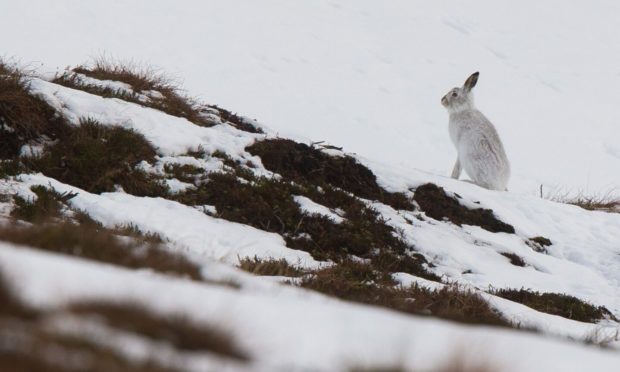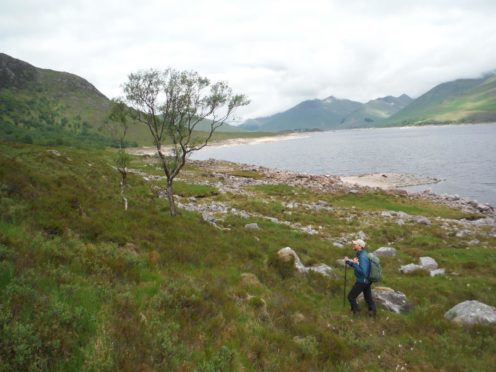“Super volunteer” Hugh Tooby is looking for help scouring Highland Perthshire and the Angus Glens for signs of the mysterious mountain hare.
Mountain hare conservation workers fear population numbers are plummeting – but the animal’s evasive nature makes it difficult to know for sure.
Hugh wants others to join the NatureScot-led teams and help build an accurate picture of mountain hare numbers.
Only then, will conservationists be able to put a long-lasting plan in place to protect the iconic animals.
Who is Hugh Tooby?
Retired-GP Hugh Tooby was one of the first to answer NatureScot’s call for volunteers.
The 60-year old took early retirement to spend more time outdoors. From there, it was a natural decision to lend a hand on projects such as the mountain hare conservation survey.
He was one of the first people to try out an app for recording sightings.
“I’d like to take this on long-term because it’s a big challenge,” he said.
Hugh has only seen two mountain hares during his recent treks.
“One very obvious problem with mountain hare is that they’re brown at this time of year, so they’re extremely well camouflaged.
“The two that I saw literally bolted from under my feet. I didn’t see them until they were just under my feet.”
The nature enthusiast, who lives in Stenhousemuir, encourages anyone who is able to get involved.
What drives Hugh?
Hugh is no stranger to jumping in his van and driving north, including Highland Perthshire, for a few days at a time.
“Even right at the beginning of my career as a medical student, I’d already developed a great love of spending time in the great outdoors.
“At the age of 52, so about eight years ago, I thought ‘you know what, I still have that hankering’. It’s been a lifelong dream.
“So I took early retirement. I’m very fortunate I had a pension I could take early retirement with — vastly reduced, but a pension was available.
“It’s given me a whole new set of challenges. I’m a great believer in lifelong learning.”
How does mountain hare conservation work?
Mountain hares are notoriously evasive in the wild. Clues such as track marks and droppings can help provide a clearer picture of the mammal’s population spread.
With that in place, officials can then decide where conservation resources can be deployed.
Spots in Tayside that are thought to be rich in mountain hares include Glen Turret and the Angus Glens, but they are mostly thought to live in the Highlands and along the West Coast.
Mountain hares are unique in that their coats change to match the season — white in winter and brown in summer.
How can I get involved?
NatureScot originally made the call for volunteers earlier this year, releasing an app for people to use.
Mountain hares are considered as “near threatened”, with best guesses putting the population around the 135,000 mark.
The app also gives tips on how to differentiate mountain hares from their brown hare cousins.
Want to help conserve mountain hares? Got a smartphone? Download the free Mammal Mapper app and #getinvolved!
More info: https://t.co/c8Jm9z46TO @Gameandwildlife @_BTO @BTO_Scotland @Mammal_Society @JamesHuttonInst @HuttonES pic.twitter.com/qhQ1Covim6
— NatureScot_NE (@NatureScot_NE) March 28, 2021
Why are there uncertainties in mountain hare conservation work?
Robert Raynor, mammals advisor with Nature Scot, hopes more information on where hares are thriving, or not, will help his team focus their resources appropriately.
They were granted protected status as it is suspected their numbers are dwindling.
However, they have a complex 10-year population cycle which sees their population numbers rise and fall, making it difficult to ascertain a trend.
What is known is that they enjoy similar habitat as grouse. This means mountain hares can often be found in managed moorlands, such as in the Angus Glens.
Robert said: “The information has not always been as comprehensive as we would have liked.
“We do not have the resources to do hare counts all the time, that’s why we’re asking for volunteers to help out.
“They can contribute something useful.”
Mountain hares play an important part in biodiversity and within the food chain, meaning conservation efforts will become increasingly vital.
“They are a very important species, such as being a part of the golden eagle’s diet.”
Have you downloaded the app? If so, and are out and about in the Tayside and Fife areas, we’d love to hear about your experiences.











